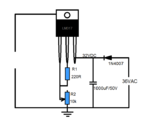abuhafss
Full Member level 2
How to test regulator IC LM317?
Hi
I am building a power supply for my project based on LM317. I have failed with 4 different regulator ICs.
Here is the circuit which I assembled on breadboard.
Initially, I used 100 ohms for R1 and 5k POT for R2. When R2 has low resistance, I could get about 1.5V. But when I increase the resistance, the POT would start frying.......I could see the flashing inside the POT. At maximum resistance, the output was more than 30V.
Next, I used 220 ohms (didn't had 240 ohms) for R1 and 10k wire wound POT for R2. At low resistance of R2, I could get 1.5V but when I increase, this time R1 fried away instead of the POT.
I have checked 4 x LM317s and got same results. Input voltage is 32V 0.5A, and I haven't yet applied any load at the output except an analog 30V meter.
Does this means, all for ICs are faulty??? I have left the 5th one un-checked. Is there any other way to check if those regulator ICs are really dude?
Hi
I am building a power supply for my project based on LM317. I have failed with 4 different regulator ICs.
Here is the circuit which I assembled on breadboard.
Initially, I used 100 ohms for R1 and 5k POT for R2. When R2 has low resistance, I could get about 1.5V. But when I increase the resistance, the POT would start frying.......I could see the flashing inside the POT. At maximum resistance, the output was more than 30V.
Next, I used 220 ohms (didn't had 240 ohms) for R1 and 10k wire wound POT for R2. At low resistance of R2, I could get 1.5V but when I increase, this time R1 fried away instead of the POT.
I have checked 4 x LM317s and got same results. Input voltage is 32V 0.5A, and I haven't yet applied any load at the output except an analog 30V meter.
Does this means, all for ICs are faulty??? I have left the 5th one un-checked. Is there any other way to check if those regulator ICs are really dude?
